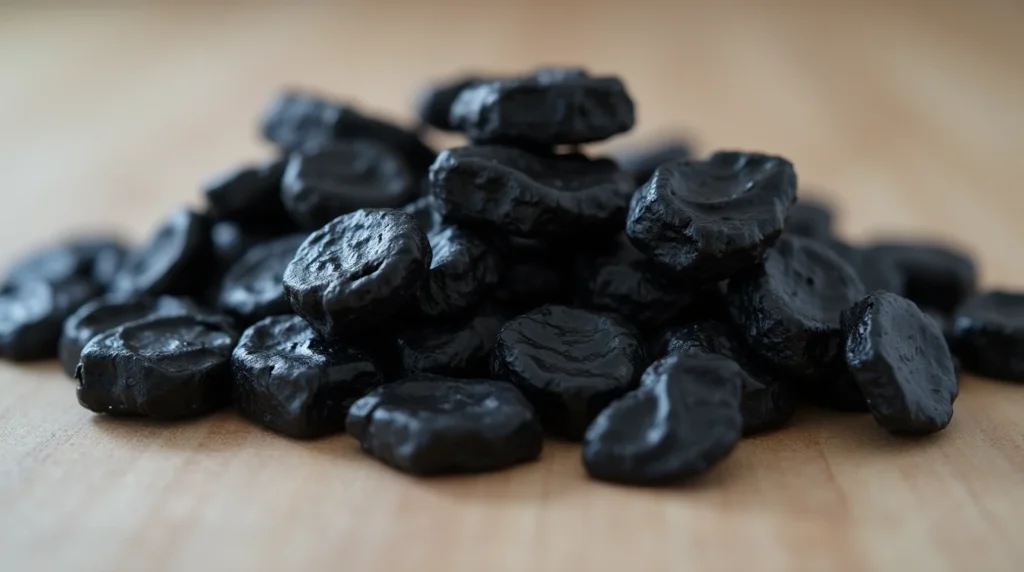Let’s journey into the flavorful world of black licorice! Perhaps you’ve spotted this iconic dark candy in the store, twisted into ropes or shaped into bite-sized pieces. Some folks can’t get enough of its sweet-but-slightly-bitter taste, while others avoid it entirely. No matter where you stand, black licorice has a fascinating story—full of ancient cures, bold flavors, and even a few controversies about its health effects.
“In ancient times, black licorice was believed to do more than just satisfy sweet cravings—it was also a respected medicinal ingredient!”
Curious about why black licorice is either loved or loathed? Hang tight. 🍬 We’ll be covering everything from its origin and production to the potential risks and benefits of chowing down on this unique treat.
Introduction to Black Licorice
Black licorice is commonly produced from the root of the licorice plant (Glycyrrhiza glabra). This plant’s root packs a powerful sweetener called glycyrrhizin, the real MVP behind that unmistakable flavor. When combined with sugar, binders, and sometimes anise oil, it transforms into the chewy candy we see on shelves everywhere.
So, why does black licorice stir such strong reactions? One reason might be its taste buds–confusing mix of sweet and bitter tones. Some palates adore the complexity, while others just find it… odd.
Quick Nutrition Snapshot
Here’s a general idea of what you might get from about 40 grams of black licorice candy:
| Nutrition Facts (Approx. 40g Serving) | Amount |
|---|---|
| Calories | ~140 |
| Carbohydrates | ~35g |
| Sugars | ~20g |
| Glycyrrhizin | Varies |
| Protein | ~2g |
| Fat | ~0g |
Note: Actual values may differ by brand or recipe.
Tracing the Origins and Evolution of Black Licorice
Ancient Roots and Medicinal Uses
If you could time-travel to ancient Egypt, you’d see black licorice root being brewed into medicinal teas or tonics. Egyptians prized its soothing qualities, using it for ailments like sore throats. They even placed licorice root in pharaohs’ tombs to ensure a comfy afterlife. Meanwhile, ancient Greek and Roman healers believed licorice could help with everything from coughs to thirst reduction.
“Licorice root was a VIP in ancient medicine, showing up in potions and brews across multiple civilizations.”
Transition into Confectionery Treats
Over time, this once strictly medicinal root hopped into the world of sweets. By the Middle Ages, various European regions were experimenting with licorice-flavored candies. The real turning point came with modern candy-making techniques, which helped black licorice become a global favorite—especially in places like the Netherlands and Scandinavia, where it remains beloved.
The Black Licorice Flavor Profile
Anise, Glycyrrhizin, and Other Key Components
Black licorice’s punchy flavor often boils down to two main players:
- Glycyrrhizin: A natural sweetener found in licorice root. It’s considerably sweeter than regular sugar.
- Anise Oil: Sometimes used to mimic or enhance the licorice taste, because pure licorice extract can be pricey or too strong.
Together, these ingredients create that signature blend of sweet, herbal, and slightly bitter tastes.
Cultural Variations in Taste Preferences
Not all black licorice tastes the same. For example, in Northern Europe—especially Finland and Sweden—salty licorice (made with ammonium chloride) is extremely popular. It’s often called “salmiak” and comes with a salty, briny punch that can be shocking if you’ve never tried it. Meanwhile, in the U.S., many black licorice candies rely heavily on anise and may not contain actual licorice root at all.
How Black Licorice Is Made
Key Ingredients and Production Steps
Bringing black licorice candy to life typically involves:
- Licorice Root Extract or Base Flavor
- Sweeteners (like sugar, corn syrup, or molasses)
- Binders and Thickeners (think flour, starch, or gelatin)
- Flavor Enhancers (anise oil, salt, etc.)
- Heating and Extrusion (cooking the mixture, shaping it into ropes or bites, then cooling it)
“Crafting black licorice is somewhat like sculpting clay: you heat it, shape it, and give it time to settle into its final delicious form.” 🍭
Major Global Brands and Their Unique Recipes
If you stroll through a candy aisle, you’ll find a variety of black licorice brands. Some use real licorice root for a bold taste, while others rely on anise. In Scandinavia, salty licorice is a hit, whereas in the U.S., sweet black licorice is more common. Each brand adds its own twist, so tasting different ones can feel like a mini world tour!
Health Benefits of Black Licorice
Potential Medicinal Properties
People have been exploring licorice’s medicinal properties for centuries. Research suggests that the root could:
- Soothe sore throats and coughs.
- Aid digestion or help with indigestion.
- Have anti-inflammatory effects due to certain plant compounds.
Remember, these perks mostly come from pure licorice root. Once you add sugar, binders, and flavorings, the candy form won’t necessarily provide the same level of health benefits.
The Role of Glycyrrhizin in Health
Glycyrrhizin is a tricky compound. On one hand, it may help with viral infections or reduce inflammation. On the other hand, excessive amounts can mess with blood pressure and potassium levels. As with most tasty treats, balance is your best friend.
“Think of glycyrrhizin like a double-edged sword—helpful in small doses, but potentially harmful if you swing it around too wildly!” ⚔️
Common Problems with Consuming Black Licorice
Everyone knows you can have too much of a good thing. Black licorice is no exception. Here are a couple of issues:
Excessive Intake and Health Risks
Eating large amounts daily could lead to:
- High Blood Pressure
- Low Potassium Levels
- Potential Drug Interactions (if you’re on certain medications)
Underlying Conditions Exacerbated by Black Licorice
If you already have heart disease, hypertension, or kidney problems, black licorice might worsen these conditions. That’s because glycyrrhizin can affect your body’s hormone balance, influencing how your system regulates fluids and electrolytes.
Controversies and Safety Concerns
FDA Warnings and Recommended Consumption Limits
The U.S. Food and Drug Administration (FDA{:rel=”dofollow” target=”_blank”}) advises caution, especially for older adults. Consuming about two ounces of black licorice daily for two weeks could trigger health issues like arrhythmia (irregular heartbeat). While two ounces might not sound like much, it’s easy to go overboard if you’re snacking mindlessly.
“Despite its candy-like sweetness, black licorice is more powerful than you might guess—both in flavor and in effect.”
Debunking Myths vs. Legitimate Dangers
No, a single nibble of black licorice won’t send you to the hospital. Most people can handle occasional indulgence just fine. But if you’re munching on it nonstop, especially if you have a preexisting condition, it’s wise to slow down.
How Much Black Licorice Is Safe to Eat?
Daily Recommended Intake
There isn’t a one-size-fits-all guideline because everyone’s tolerance varies. Health experts often say to keep it moderate—just a few pieces, not an entire bag in one sitting. If you notice anything weird, like dizziness or muscle weakness, it might be time to cut back.
Age and Health Considerations
Kids and older adults should be particularly careful since they might be more sensitive to glycyrrhizin’s effects. Always remember: no treat is worth risking your well-being.
“When in doubt, treat black licorice like a super spicy pepper—fun to try, but probably best in small bites!” 🌶️
Practical Tips for Enjoying Black Licorice Responsibly
How do you satisfy that licorice craving without jeopardizing your health?
- Check Product Labels
Some products use real licorice root extract, while others rely on anise flavoring. If you’re worried about glycyrrhizin, look for items with reduced glycyrrhizin content or no licorice extract. - Pair It Wisely
Balance out the strong flavor by enjoying black licorice with fresh fruit or a glass of water. This can help prevent sugary overload and keep you hydrated. - Monitor Your Servings
A handful of pieces every now and then is generally fine for most healthy individuals. But if you have heart or kidney issues, be extra cautious. - Combine with Other Flavors
Pair black licorice with tangy or spicy elements—like ginger or citrus—to tone down the bitterness and add complexity.
“Black licorice is kind of like a thunderstorm—dramatic and intense, but captivating in small doses!” ⛈️
- Explore Similar Flavors
If pure licorice root is too strong, you might enjoy candies that rely on anise or fennel for a milder yet somewhat similar taste.
Internal Link Note: Speaking of fennel, you may want to explore other uses of this aromatic plant, like in fennel sausage recipes{:rel=”dofollow” target=”_blank”}—it can add a unique twist to your meals without the sweetness of candy.
Creative Ways to Use Black Licorice in the Kitchen
Who says black licorice belongs only in a candy bag? Check out these imaginative ideas:
- Licorice Crumble Topping
Crush some black licorice candies and sprinkle them over cupcakes or ice cream for a sweet, crunchy finish. - Infused Sauces and Glazes
Simmer black licorice pieces in water to make a simple syrup, then stir it into barbecue sauces or meat glazes for a unique flavor twist. - Stews and Braises
Toss a small piece of black licorice into hearty dishes like beef stew. It adds a subtle depth that might surprise your taste buds. - Hot Licorice Drinks
Melt black licorice in hot milk or tea. You can even spice it up with cinnamon or nutmeg for an extra comforting drink. - Dessert Experiments
Chefs and bakers often pair licorice with fruits (like berries) to highlight the contrast between sweet and slightly bitter or salty notes.
“Cooking with black licorice is like discovering a secret door in your kitchen—once you open it, you’ll find all kinds of magical possibilities.” 🍲
Recipe Ideas and Pairings
Easy Homemade Black Licorice Candy
Sure, you can buy black licorice, but making it at home gives you control over sweetness, texture, and intensity. Here’s a quick ingredient guide (makes around 20 pieces):
Block Quote Recipe Overview:
“Homemade black licorice is all about experimentation—tweak the sugar, stir in some molasses, or add extra anise for a flavor that’s truly yours.”
| Ingredient | Quantity | Notes |
|---|---|---|
| Sugar | 1 cup | Granulated or brown |
| Molasses or Dark Syrup | 3 tbsp | For rich depth |
| Water | ½ cup | Helps dissolve ingredients |
| Licorice Root Extract | 2 tsp | Adjust to taste |
| Anise Oil (optional) | ¼ tsp | Enhances licorice-like flavor |
| All-Purpose Flour | ~1 cup | Binding agent (adjust as needed) |
| Salt | 1 pinch | Balances the sweetness |
Condensed Instructions:
- In a saucepan, mix sugar, molasses, and water over low heat.
- Stir until the sugar dissolves.
- Add licorice root extract (and optional anise).
- Gently whisk in flour to form a dough.
- Cool slightly, roll into ropes, and cut into pieces.
- Let them set, then store in an airtight container.
Pro Tip: For an extra dark color, some folks use activated charcoal powder or cocoa powder.
Drink Pairings: Coffee, Tea, Wine, and More
- Coffee: Licorice’s robust flavor can match a strong espresso.
- Herbal Tea: Fennel or anise teas highlight the candy’s natural sweetness.
- Red Wine: A bold, spicy wine (like Syrah) complements licorice-infused desserts.
- Cocktails: Try mixing sambuca (an anise-flavored liqueur) with lemon juice and sparkling water.
“Don’t hesitate to invite black licorice to your beverage menu—it can spice up your drink in all the best ways.” 🥂
Cultural Significance Around the World
Popularity in Scandinavian Countries
In Finland and Sweden, salty licorice (often labeled as “salmiak”) is a cultural phenomenon. People snack on it like it’s the only candy on earth. It’s not unusual to find salted licorice-flavored ice cream, chocolate bars, or even alcoholic beverages in these regions.
Block Quote on Salty Licorice:
“Nordic salty licorice can be a shock to the uninitiated—like diving into ice-cold water—but loyal fans can’t imagine life without it.” ❄️
Traditions in Other Regions
- The Netherlands: Dutch “drop” comes in endless varieties—some sweet, some extremely salty.
- United Kingdom: Pontefract is famous for licorice “cakes,” historically linked to locally grown licorice roots.
- United States: Although not as widespread, black licorice remains a nostalgic treat, particularly around Halloween.
Shopping Tips and Storage Advice
- Look for Real Extract
If authenticity matters to you, check for “licorice root extract” in the ingredients list rather than just anise flavor. - Mind the Sugar Content
Many licorice products are loaded with sugar or corn syrup. If you’re monitoring sugar intake, opt for brands claiming “reduced sugar” or “sugar-free.” - Cool, Dry Storage
Keep licorice in an airtight container, stored away from heat and humidity to maintain texture and taste. - Buy Smaller Packs
If you’re sampling a new brand or style (like salty licorice), get the smallest size first. That way, you’re not stuck with a giant bag of candy you don’t like.
“Think of black licorice like a fine piece of art—treat it well, store it properly, and it’ll reward you with an outstanding experience.” 🖼️
Common Questions and FAQs
Why Do Some People Dislike Black Licorice?
Taste buds aren’t universal. Some folks love bold, slightly bitter flavors; others find them off-putting. There’s also a psychological element—licorice’s medicinal past might make its flavor feel “un-candy-like” to some.
Is Red Licorice Really Licorice?
Typically, no. Red licorice candies usually rely on fruit flavors, like strawberry or cherry, and often skip licorice root extract altogether. They share a similar shape and name but not the authentic licorice taste.
Block Quote Clarification:
“Think of red licorice as the distant cousin who has the name but none of the signature ‘licorice’ personality traits.”
Future Trends and Innovations in Black Licorice
Don’t think for a moment that black licorice is stuck in the past. Innovation is on the horizon!
Health-Conscious Formulations
As consumers get more health-savvy, manufacturers are exploring:
- Organic Licorice: Made with fewer artificial additives.
- Low-Sugar or Sugar-Free Options: Employing stevia or monk fruit as alternative sweeteners.
- Gluten-Free and Vegan Variants: Using plant-based gums and starches instead of wheat flour.
Emerging Flavor Combinations
From chili-infused black licorice to licorice-lime sorbets, the possibilities keep growing. Even craft breweries and distilleries are experimenting with licorice-infused beverages.
“Who knows? Maybe your next favorite licorice treat will involve a mix of bold spices and an unexpected fruity twist.” 🍒
Conclusion: Enjoying Black Licorice with Awareness and Creativity
Black licorice is so much more than a chewy snack. It carries ancient heritage, offers a flavor punch, and even sparks controversies over health implications. By balancing your intake and staying informed, you can appreciate its unique qualities without stress.
- Stay Informed: Understand glycyrrhizin and its effects on health.
- Moderate Consumption: Enjoy just a few pieces at a time, especially if you’re at risk for high blood pressure or other conditions.
- Experiment in the Kitchen: Use licorice syrup in sauces, stews, and desserts.
- Celebrate Diversity: From salty Nordic licorice to sweet American varieties, each region brings its own twist.
- Look Ahead: Embrace new formulations and flavor combos that take black licorice beyond its traditional role.
Block Quote Inspiration:
“Black licorice proves that not all sweets are created equal—sometimes the most intriguing treats have a touch of the unexpected.” ⚡
Additional Resources
- Learn more about licorice root’s health benefits on Healthline{:rel=”dofollow” target=”_blank”}.
- Check out FDA guidelines for a safer approach to black licorice consumption here{:rel=”dofollow” target=”_blank”}.
- Dive into scientific studies on licorice at PubMed{:rel=”dofollow” target=”_blank”}.
Thank you for joining this deep dive! With a little knowledge and an adventurous palate, black licorice can be a delightful (and occasionally daring) part of your culinary life. So go ahead—give it a try, whip up a homemade batch, or even dare to cook with it. You might just discover a brand-new favorite way to get sweet on life. 🍭



